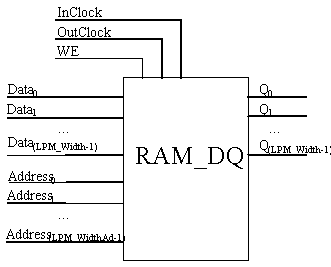![]()
Copyright © 1998 University of Manchester
|
|
|
4.4.4 LPM_RAM_DQ |
|
Copyright © 1998 University of Manchester |

Ports:
| Description | Comments | |||
| Data input to memory | Vector, LPM_Width wide | |||
| Address of memory location | Vector, LPM_WidthAd wide | |||
| Output of memory | Vector, LPM_Width wide | |||
| Synchronous load of memory | ||||
| Synchronous Q outputs from memory. | ||||
| Write enable control. Enables write to the memory when high (1). | Note 3 |
Note 1: If the InClock port is used, then the WE port acts as an enable for write operations synchronized to the positive going edge of the signal on the InClock port. If the InClock ports is not used, then the WE port acts as an enable for write operations asynchronously.
Note 2: The addressed memory content to Q response is synchronous when the OutClock port is connected. and asynchronous when it is not connected.
Note 3: If only WE is used, the data on the Address port should not change while WE is active (high, 1). If the data on the Address port changes while WE is high (1), then all memory locations that are addressed are over-written with Data.
Properties
| Value | Comments | ||
| LPM Value > 0 | Width of input and output vectors. | ||
| LPM Value > 0 | Width of Address Port. Note 1. | ||
| LPM Value > 0 | Number of words stored in Memory. Note 2. | ||
| REGISTERED | UNREGISTERED | Indicates if Data port is registered. Default is REGISTERED | ||
| LPM_Address_Control | REGISTERED | UNREGISTERED | Indicates if Address and WE ports are registered. Default is REGISTERED | |
| REGISTERED | UNREGISTERED | Indicates if Q port is registered. Default is REGISTERED | ||
| File Name | File for RAM initialization. |
Note 1: The LPM_WidthAd should be (but is not required to be) equal to: log2(LPM_NumWords). If LPM_WidthAd is too small, some memory locations will not be addressable. If it is too big, then the addresses that are too high will return UNDEFINED.
Note 2: If LPM_NumWords is not used, then it defaults to 2LPM_WidthAd. In general, this value should be (but is not required to be): 2LPM_WidthAd-1 < LPM_NumWords < = 2LPM_WidthAd.
Functions
Random Access Memory. This module can represent asynchronous memory or memory with synchronous inputs and/or outputs.
Synchronous Memory Operations
Synchronous Write to memory
| No change | ||
| No change (requires positive going clock edge) | ||
| rising edge | The memory location pointed to by Address is loaded with Data. Controlled by WE. |
Synchronous Read from memory
| No Change | |
| rising edge | The output register is loaded with the contents of the memory location pointed to by Address. Q outputs the contents of the output register. Note 1 |
Note 1: WE does not act as a clock enable for the output clock.
Asynchronous Memory Operations
Totally asynchronous memory operations occur when neither InClock nor OutClock is connected.
| Memory Contents | |
| No change | |
| The memory location pointed to by Address is loaded with Data. Controlled by WE. |
The output Q is asynchronous and reflects the data in the memory to which Address points.